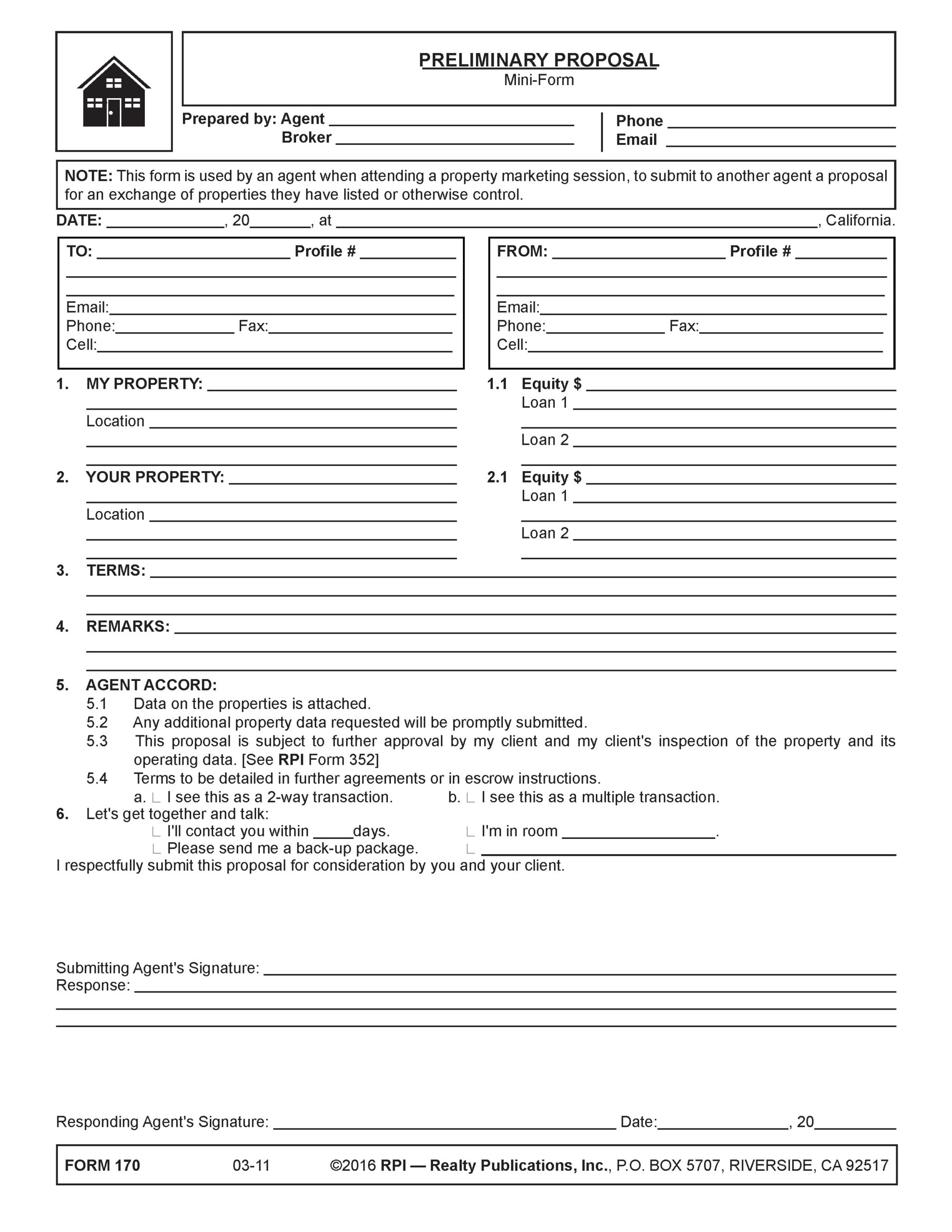This form is used by an agent when attending a property marketing session, to submit to another agent a proposal for an exchange of properties they have listed or otherwise control.
Swapping properties, equities and mortgage debt
An exchange of properties is a multi-property “sales” transaction structured as a barter — a swap — entered into by the respective owners of two or more parcels of real estate, each having value in their equity.
By an agreement, ownership of the properties is transferred between owners by the concurrent conveyancing of the properties, the value of the equity in one property being part or all the consideration given for the equity in the other property.
The exchange transaction, often called a trade, is in fact separate sales of two properties each owned by different persons, which are acquired — purchased — by the other person.
Exchanges occur most frequently during the recessionary phase of a business cycle when cash becomes scarce — king. During recessions, property owners frequently are unable (or unwilling) to part with cash and the supply of properties whose owners need to sell are plentiful.
Financial adjustments are arranged for the difference in the dollar value of equity in each property based on the dollar amount given each in the exchange agreement. The dollar values set for pricing and equity do not affect income tax reporting, but cash and mortgage balances are part of the tax reporting on the transaction. [See RPI e-book Tax Benefits of Ownership, Chapter 23]
Thus, an owner of real estate, on entering into a written exchange agreement, agrees to sell and convey their property to the other owner who agrees to purchase and acquire it — take it in trade.
However, unlike a sale under a purchase agreement, the down payment on the agreed price is not in the form of cash. Rather, the down payment on the property acquired is the equity in a property the owner wants to dispose of.
Unlike a sale calling for a cash down payment and assumption of an existing mortgage or new financing, any balance of the price remaining to be paid on the price in an exchange is often deferred, evidenced by a carryback note and trust deed.
Exchanges frequently have little to no cash involved beyond transactional costs, a side effect of the times when exchanges are more prevalent at marketing sessions.
Locating properties for exchange
When searching for replacement properties, the owner’s agent first locates suitable properties owned by someone interested in acquiring the client’s property.
The agent contacts agents who have listed suitable property to determine whether their client is interested in acquiring property in exchange. If so, whether they are willing to acquire the type of property owned by the agent’s client.
A prudent agent will not prepare or submit an offer to exchange before obtaining an understanding that the other owner has a willingness to consider an exchange of properties.
To look into the possibility of an exchange for a property of the type a client will accept, and to document the inquiry for later follow up, an agent will often prepare a preliminary proposal form. It is delivered to the other agent to encourage discussions — the catalyst needed to explore the probability of an exchange. [See RPI Form 170]
The proposal form notes the type of properties involved, the amount of equity and debt, and arranges for the exchange of property information for a discussion between the agents before preparing an exchange agreement. [See RPI Form 170]
The agent retains a copy of the prepared form in the client file as evidence of the agent’s duty owed to the client to diligently locate property. [See RPI Form 170]
The preliminary proposal is not an offer. As a proposal, it does not contain intent-to-contract wording. The clients are not directly involved in the proposal, only the agents who are looking for a possible match.
On determining the probability of the other owner to enter into an exchange, the agent prepares an exchange agreement, gathers signatures, and submits it for consideration. [See RPI Form 171]
Analyzing the preliminary proposal
An agent uses the Preliminary Proposal — Mini-Form published by Realty Publications, Inc. (RPI) when attending a live or online property marketing session. The form allows the agent to hand deliver or email their proposal for an exchange of properties to the agent who has listed or otherwise controls a target property. [See RPI Form 170]
The Preliminary Proposal contains:
- the date;
- the responding agent’s information;
- the submitting agent’s information;
- the submitting agent’s property, location, and equity amounts;
- the responding agent’s property, location and equity amounts;
- terms of the intended sale;
- any special remarks from either party;
- whether the agent sees this as a two-way transaction or a multiple transaction;
- additional contact details;
- the submitting agent’s signature; and
- the responding agent’s signature. [See RPI Form 170]
Form navigation page published 08-2023.
Form last revised 2016.
Form-of-the-Week: Preliminary Proposal and Exchange Agreement — Forms 170 and 171
Article: Property exchanges when Cash is King
Article: Economic considerations in an evaluation: Part 2
Article: Form 171 – The formal exchange agreement
FARM: §1031 exchange
Book: Tax Benefits of Ownership, Chapter 23: A formal exchange of properties














